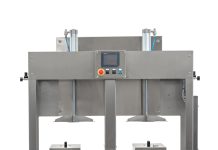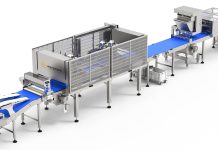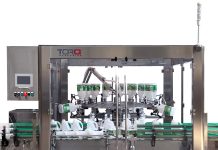 They were first discovered in 1972 by means of electron microscopy, after a 1968 outbreak of gastroenteritis at an elementary school in Norwalk (Ohio). This virus is recognized as the most frequent cause of waterborne infections in the United States, as it is responsible for approx. 23% of all viral waterborne infections. These viruses are stable in the environment and can survive freezing (0°C) and heating to 60°C, as well as high chlorine concentrations of 10 ppm; this makes their elimination from drinking water very difficult. Virus particles suspended in water with chlorine concentrations of 3.75 mg/l and 6.25 mg/l, 0.5 and 1 mg/l residual, corresponding to what allowed in drinking water systems, are still infective and capable of causing illness. Even treatment of the virus with 10 mg/l is not effective in inactivating the virus; in fact, 1/8 of the voluntary patients submitted to trials have become sick from Norovirus infection. The presence of viral RNA has been repeatedly documented even in uncarbonated mineral water. These viruses cause gastroenteritis, more frequently in adults, especially if weak, and are spread worldwide, whereby humans are the sole known hosts. In Switzerland no accurate data on the frequency of Norovirus-related outbreaks are available, since this disease is not subject to obligatory reporting regulations. It is known, however, that in 2002 many hospitals registered one or more outbreaks. In the U.K., 5241 outbreaks have been reported between 1992 and 2000, and in Germany some thousand cases are reported every year. Even in Italy small epidemic focuses have been reported (2002, Gulf of Taranto), but unfortunately there is no national surveillance system for nonbacterial gastroenteritis. As for transmission routes, viruses are excreted with feces and vomit. Transmission mainly occurs via personto- person contact; however, even indirect transmission has been documented via contaminated surfaces or by the respiratory route. Outbreaks caused by ingestion of contaminated foods and waters have been reported, especially in the United States. Among the potentially dangerous foods, there are shellfish and mussels. The minimum levels of contamination are very low (10-100 viral particles). The incubation period goes from 15 to 48 hours, and the transmission risk persists for at least 48 hours since the disappearance of clinical symptoms. The virus, however, can be identified in the feces for an additional period of one or two weeks, although the transmission risk during this phase is very low. The disease starts with acute symptoms characterised by diarrhoea and continuous vomiting. Generally no other general symptoms are present, such as high temperature etc. By analysing the available literature on this matter, it results that Noroviruses, especially Norwalk-like Viruses, are more frequently analysed and identified in mineral waters, followed by HAV, Echovirus and Coxsackievirus.
They were first discovered in 1972 by means of electron microscopy, after a 1968 outbreak of gastroenteritis at an elementary school in Norwalk (Ohio). This virus is recognized as the most frequent cause of waterborne infections in the United States, as it is responsible for approx. 23% of all viral waterborne infections. These viruses are stable in the environment and can survive freezing (0°C) and heating to 60°C, as well as high chlorine concentrations of 10 ppm; this makes their elimination from drinking water very difficult. Virus particles suspended in water with chlorine concentrations of 3.75 mg/l and 6.25 mg/l, 0.5 and 1 mg/l residual, corresponding to what allowed in drinking water systems, are still infective and capable of causing illness. Even treatment of the virus with 10 mg/l is not effective in inactivating the virus; in fact, 1/8 of the voluntary patients submitted to trials have become sick from Norovirus infection. The presence of viral RNA has been repeatedly documented even in uncarbonated mineral water. These viruses cause gastroenteritis, more frequently in adults, especially if weak, and are spread worldwide, whereby humans are the sole known hosts. In Switzerland no accurate data on the frequency of Norovirus-related outbreaks are available, since this disease is not subject to obligatory reporting regulations. It is known, however, that in 2002 many hospitals registered one or more outbreaks. In the U.K., 5241 outbreaks have been reported between 1992 and 2000, and in Germany some thousand cases are reported every year. Even in Italy small epidemic focuses have been reported (2002, Gulf of Taranto), but unfortunately there is no national surveillance system for nonbacterial gastroenteritis. As for transmission routes, viruses are excreted with feces and vomit. Transmission mainly occurs via personto- person contact; however, even indirect transmission has been documented via contaminated surfaces or by the respiratory route. Outbreaks caused by ingestion of contaminated foods and waters have been reported, especially in the United States. Among the potentially dangerous foods, there are shellfish and mussels. The minimum levels of contamination are very low (10-100 viral particles). The incubation period goes from 15 to 48 hours, and the transmission risk persists for at least 48 hours since the disappearance of clinical symptoms. The virus, however, can be identified in the feces for an additional period of one or two weeks, although the transmission risk during this phase is very low. The disease starts with acute symptoms characterised by diarrhoea and continuous vomiting. Generally no other general symptoms are present, such as high temperature etc. By analysing the available literature on this matter, it results that Noroviruses, especially Norwalk-like Viruses, are more frequently analysed and identified in mineral waters, followed by HAV, Echovirus and Coxsackievirus.
Testing Methods

Diagnostic methods presently used for the identification of viruses in bottled mineral waters implement the reverse transcription-PCR method also called RT-PCR (Reverse Transcriptase PCR). This is due to the fact that the analysed viruses are RNA viruses without envelope, and for this reason they cannot be identified with conventional methods. The first step consists in the RNA extraction, followed by a reaction of reverse transcription, in order to transform the RNA into cDNA and subsequent PCR. The implemented method consists in using 2-litre water samples, suitably filtered via membrane filter technique with positive charge, having a 0.45-m pore size, and a membrane measuring 47-mm in diameter. RNA is to be extracted with adequate kits, according to the protocol described in the following. Finally, the RT-PCR rate is directly extracted with specific primers for the various types of viruses.
Standard Protocol
The standard protocol for the concentration and detention of viruses consists in filtering 2-litre water samples using a membrane filter with positive charge (90-mm diameter; 0.45-μm pore size). The test sample is then washed by letting flow through the membrane filter 200 ml of NaOH at pH 10.5; the filtered sample is then eluted with 10 ml of H2SO4 at pH 3.0, and the filtered sample is then neutralized using 50 l NaOH and 100x TE buffer. At this point, the test sample can be concentrated again by transferring 10
ml of eluate in Centriprep Concentrator, which is then concentrated by centrifugation at 1.500/r.p.m. at 4°C. After removing removal of the suspended matter, the test sample is washed twice using MilliQ water, in order to obtain the final volume of 2 ml. The pre-treated test sample is now ready for RNA extraction, followed by reverse transcriptase, in order to transform RNA into cDNA, which will be then submitted to PCR. For RNA extraction, starting from a 300-μl test sample, the kits available on the market can be uses, as QIAmp viral RNA mini kit-QIAGEN. The obtained sample is subsequently submitted to RT-PCR with specific primers for the various viruses (Norovirus, Echovirus, HAV and Coxsackievirus) using the RTPCR. Eppendorf master mix containing both RT and Taq polymerase. Thedescribed method is illustrated as a scheme in Figure 1.



